Wonder of the Week
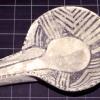 Ladles or scoops were made throughout the pre-Hispanic Southwest to be used much as we use serving spoons today. This ladle is attributed to Pueblo Indigenous peoples from 900–1150 AD, in the time referred to as Pueblo II, where Indigenous cultures
Ladles or scoops were made throughout the pre-Hispanic Southwest to be used much as we use serving spoons today. This ladle is attributed to Pueblo Indigenous peoples from 900–1150 AD, in the time referred to as Pueblo II, where Indigenous cultures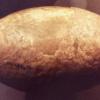 With over 3000 specimens, the University of Colorado Museum of Natural History has one of the most extensive fossil eggshell collections in the Rocky Mountain region. The vast majority of the fossil eggshell specimens in CU’s collection were added by Mr. Karl Hirsch, an amateur fossil collector who started studying fossil eggshells in the 1960s.
With over 3000 specimens, the University of Colorado Museum of Natural History has one of the most extensive fossil eggshell collections in the Rocky Mountain region. The vast majority of the fossil eggshell specimens in CU’s collection were added by Mr. Karl Hirsch, an amateur fossil collector who started studying fossil eggshells in the 1960s.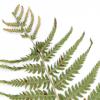 Lady fern (Athyrium filix-femina), also known as the alpine lady fern, is an uncommon plant in Colorado but can be found in 49 out of 50 states, excluding Hawaii, making it one of the most abundant ferns in the U.S. The telltale mark of a lady fern are clusters of reddish or bright green sori, or spore sacs, on the underside of its almost lacy, feathered fronds. These sori identify the filix-femina as a pteridophytes, a group of vascular plants that reproduce by spores rather than seeds.
Lady fern (Athyrium filix-femina), also known as the alpine lady fern, is an uncommon plant in Colorado but can be found in 49 out of 50 states, excluding Hawaii, making it one of the most abundant ferns in the U.S. The telltale mark of a lady fern are clusters of reddish or bright green sori, or spore sacs, on the underside of its almost lacy, feathered fronds. These sori identify the filix-femina as a pteridophytes, a group of vascular plants that reproduce by spores rather than seeds.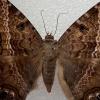 Ascalapha odorata, sometimes known as The Black Witch is a migratory moth found commonly in the tropics of the Americas. This moth is the largest insect in the continental United States with a wingspan of up to 7 inches. The characteristically long forewings and nocturnal habits make the Black Witch superficially resemble bats, which they can easily be mistaken for while in flight.
Ascalapha odorata, sometimes known as The Black Witch is a migratory moth found commonly in the tropics of the Americas. This moth is the largest insect in the continental United States with a wingspan of up to 7 inches. The characteristically long forewings and nocturnal habits make the Black Witch superficially resemble bats, which they can easily be mistaken for while in flight.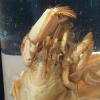 If you were to investigate an estuary (where freshwater rivers meet oceans) or intertidal flat along the United States’ west coast, you might happen across crustaceans that are commonly known as blue mud shrimp (Upogebia pugettensis).
If you were to investigate an estuary (where freshwater rivers meet oceans) or intertidal flat along the United States’ west coast, you might happen across crustaceans that are commonly known as blue mud shrimp (Upogebia pugettensis).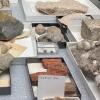 Invertebrates are animals that do not have the internal structures that form a backbone. They frequently form external skeletal structures made of calcium carbonate (picture seashells and snail shells). It is these hard, protective coverings that
Invertebrates are animals that do not have the internal structures that form a backbone. They frequently form external skeletal structures made of calcium carbonate (picture seashells and snail shells). It is these hard, protective coverings that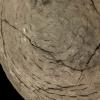 Pottery in the Northern Southwest is constructed by coiling ropes of clay and scraping the surface to obliterate the coils. Corrugated pottery, like the one featured here, is not scraped smooth on the exterior surface; instead, coils are pinched together, sometimes leaving behind fingerprints from their makers. This vessel, an olla, was recovered near Aztec Ruins National Monument in northern NM and dates back nearly 1000 years ago. Archaeologists believe it was likely used for storage due to its large size. The photo shows its base, where the clay began to be coiled.
Pottery in the Northern Southwest is constructed by coiling ropes of clay and scraping the surface to obliterate the coils. Corrugated pottery, like the one featured here, is not scraped smooth on the exterior surface; instead, coils are pinched together, sometimes leaving behind fingerprints from their makers. This vessel, an olla, was recovered near Aztec Ruins National Monument in northern NM and dates back nearly 1000 years ago. Archaeologists believe it was likely used for storage due to its large size. The photo shows its base, where the clay began to be coiled.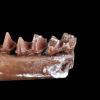 Oreotalpa is thought to be the oldest North American member of the Talpidae, a family that includes today’s moles, shrew-moles, and desmans–an insectivorous mole with a long snout! Discovered in 2008 by Dr. Jaelyn Eberle and team from the University of Colorado Museum of Natural History, Oreotalpa literally means ‘mountain mole’ (oreo = mountain; talpa = mole) and was named for its discovery in Colorado’s Rocky Mountains. The fossil was discovered in late Eocene (34-million-year-old) rocks at Florissant Fossil Beds National Monument in Colorado, famous for its giant petrified redwood stumps and fossil insects.
Oreotalpa is thought to be the oldest North American member of the Talpidae, a family that includes today’s moles, shrew-moles, and desmans–an insectivorous mole with a long snout! Discovered in 2008 by Dr. Jaelyn Eberle and team from the University of Colorado Museum of Natural History, Oreotalpa literally means ‘mountain mole’ (oreo = mountain; talpa = mole) and was named for its discovery in Colorado’s Rocky Mountains. The fossil was discovered in late Eocene (34-million-year-old) rocks at Florissant Fossil Beds National Monument in Colorado, famous for its giant petrified redwood stumps and fossil insects.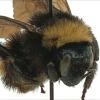 The American Bumble Bee, Bombus pensylvanicus, is one of the most common bumble bee species found on the Front Range and is one of the 24 species found in Colorado. This species is found only in the lower elevations of the state (3500-5500 feet above sea level) and its range is one of the greatest for all North American bumble bees stretching from the grasslands east of the Rocky Mountains all the way to the coastal Atlantic states, north into Canada and south into Mexico.
The American Bumble Bee, Bombus pensylvanicus, is one of the most common bumble bee species found on the Front Range and is one of the 24 species found in Colorado. This species is found only in the lower elevations of the state (3500-5500 feet above sea level) and its range is one of the greatest for all North American bumble bees stretching from the grasslands east of the Rocky Mountains all the way to the coastal Atlantic states, north into Canada and south into Mexico.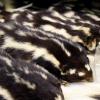 The Eastern spotted skunk gets its name from the broken stripes along its back. Both the Eastern and Western spotted skunk ranges overlap in Colorado. Eastern spotted skunks are the only species of skunk known to climb, inhabiting rocky, woody or tallgrass prairie habitats, while the western spotted skunk prefers rocky canyons and brushlands. Like other Mephitids, (the family of mammals including skunks and stink badgers) spotted skunks are nocturnal. While they are famous for the oily musk excreted when threatened, not every encounter with a skunk results in getting sprayed. When startled, frightened or intimidated, skunks will often give fair warning with an elaborate handstand stance before taking aim. This natural tear gas emerges from well-developed scent glands located on either side of their anus and can accurately mist predators 20 feet away!
The Eastern spotted skunk gets its name from the broken stripes along its back. Both the Eastern and Western spotted skunk ranges overlap in Colorado. Eastern spotted skunks are the only species of skunk known to climb, inhabiting rocky, woody or tallgrass prairie habitats, while the western spotted skunk prefers rocky canyons and brushlands. Like other Mephitids, (the family of mammals including skunks and stink badgers) spotted skunks are nocturnal. While they are famous for the oily musk excreted when threatened, not every encounter with a skunk results in getting sprayed. When startled, frightened or intimidated, skunks will often give fair warning with an elaborate handstand stance before taking aim. This natural tear gas emerges from well-developed scent glands located on either side of their anus and can accurately mist predators 20 feet away!

